#ogg vorbis
Explore tagged Tumblr posts
Text
I have a strange question.
Lossy audio compression formats work by cutting out frequencies that are difficult for humans to hear. Most humans cannot easily hear the difference between a medium-quality mp3 and a lossless audio file. But cats can hear higher frequencies than we can, so to them, even a high quality lossy file could sound quite different from the original.
I do not currently have a cat, but I hope to have cats someday, and I want to play some songs from my music collection for them to see what they think. My music collection is rather large and I would prefer not to have too many FLAC files.
Does anyone have any idea which lossy audio format(s) would create the best potential listening experience for a cat?
#cats#audiophile#computer science#mp3#flac#audio compression#ogg vorbis#and now for something completely different#how animals work#terminal penguinitis
14 notes
·
View notes
Note
Just dropping in to say I love ogg vorbis so much thabk u

i am always glad to see he is enjoyed
4 notes
·
View notes
Text
Experience the New X4: Timelines DLC Storyline

X4: Timelines DLC launch expands the game with further update details across Linux and Windows PC. Thanks to the talent and skill of Egosoft's developers. Available on Steam, GOG, and Humble Store. Get ready to dive into an epic space adventure with X4: Timelines DLC. This new storyline in the X4 universe for Linux, full of scenarios that let you take on all the different aspects of X4 gameplay. As you play through these scenarios, you’ll unlock even more content within the X4: Timelines storyline. Plus, you’ll also earn rewards for your main X4 sandbox universe. Including revamped ships, new systems, points of interest, and even a new faction in the game. You’ll launch into the shoes of Harper Donel, a trader in the border territories who isn’t afraid to take risks. A chance encounter will not only shake up your immediate plans but also change your understanding of the universe and everyone in it. So get ready for a story full of intrigue and mind-blowing revelations.
X4: Timelines DLC - Story Trailer
youtube
X4: Timelines is here to take you on an unprecedented space journey. This latest addition to the X4 universe also uses fresh and exciting ways to introduce new players to the core mechanics. Long-time space adventurers are in for a treat too, with a gripping new storyline that takes place outside the usual sandbox. Brace yourself for massive challenges and unexpected dives into the rich lore and history of the X series. This expansion is your gateway to unexplored territories and untold stories. Just select ‘Timelines’ from the main menu of X4: Foundations and embark on an adventure that transcends time and space. Along the way, you’ll unlock various bonuses for your X4 sandbox universe. This isn’t just an expansion; it’s also a game-changer for this universe. Whether you’re a seasoned space explorer or new to the galaxy, this thrilling new chapter promises to captivate you with its blend of mystery, adventure, and strategic gameplay. Check out the FAQ for even more details. So, what are you waiting for? Launch into X4: Timelines and experience a whole new dimension of space exploration and storytelling. It’s time to see the X4 universe like never before. Available on Steam, GOG, and Humble Store for on Linux & Window PC. Priced at $14.99 USD / £12.49 / 14,99€.
#x4 timelines#space sim#dlc#x4 foundations#linux#gaming news#egosoft#ubuntu#windows#pc#ogg#vorbis#openal#tobii#Youtube
0 notes
Link
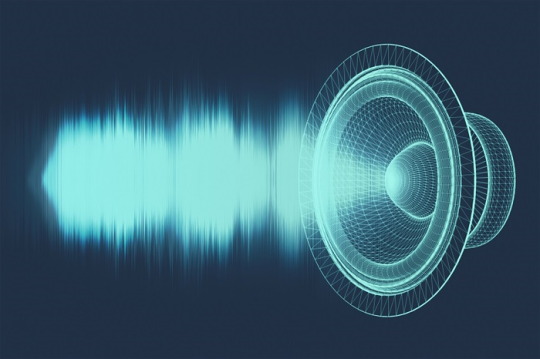
L’audio digitale rappresenta il suono tramite una serie di valori discreti, chiamati campioni, che sono convertiti in una sequenza di numeri binari (0 e 1). Il metodo più utilizzato per rappresentare segnali audio in formato digitale è il PCM (Pulse Code Modulation) . È un tipo di modulazione utilizzata per convertire segnali analogici, come la musica o la voce, in segnali digitali che possono essere memorizzati, elaborati e trasmessi. Il processo di conversione implica due fasi principali: la quantizzazione e il campionamento. Nel campionamento, il segnale analogico viene misurato a intervalli regolari di tempo per produrre una sequenza di valori discreti. Durante la quantizzazione, questi valori vengono arrotondati a un insieme limitato di valori possibili, che vengono poi rappresentati come numeri binari. Dopo la rappresentazione in segnale audio digitale PCM il file può essere inviato senza compressione alcuna oppure compresso cercando comunque di mantenere la qualità audio entro valori accettabili [continua...] AAC bitrate cuffie dolby dolby atmos dolby true hd dts-hd dts:x flac mp3 mqa napster ogg vorbis opus pcm picks tidal wma
#AAC#bitrate#cuffie#dolby#dolby atmos#dobly true hd#dts-hd#dts:x#flac#mp3#MQA#napster#ogg#vorbis#opus#pcm#tidal#wma#qobuz
0 notes
Text
juke_joint_jezebel_-_post-bop_cover.ogg
0 notes
Text
"Support for Ogg Vorbis" can either mean something can play an open source audio format or it's a political campaign for a caveman called Ogg Vorbis
41 notes
·
View notes
Note
[points] she doesn't know about the ogg vorbis audio file format
Leave me alone I'm not an electronic music tgirl 😭😭😭
145 notes
·
View notes
Text
remember to ogg your vorbis at least once a day
38 notes
·
View notes
Text
An ode to the iRiver iHP-120
For whatever reason, I've found myself deeply nostalgic for high school as of late. And for me, that is intractable from nostalgia for what is perhaps the peak mp3 player ever made:
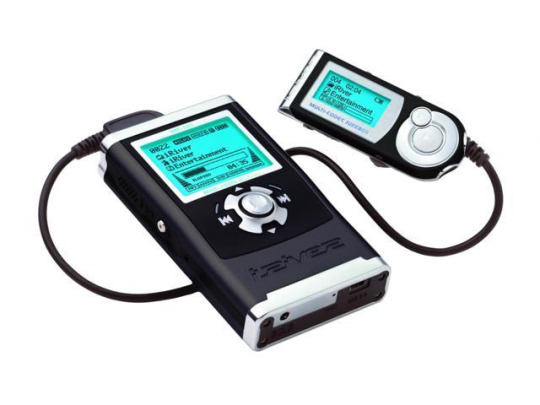
The iRiver iHP-120 was released in 2003, my sophomore year of high school, and it changed my life. This thing held an astounding 10GB of music—for comparison, most mp3 players at the time were flash based, and held 128 or 256 MB of music. The only big competitor at the time was the 1st generation iPod, a mac-exclusive device that transferred data over firewire and had to be synced using the fledgling iTunes. Juxtapose that to iRiver, who took what I like to call the "we don't give a fuck" approach:
When you plugged in the iHP-120 with USB 2.0, it just showed up as an external hard drive—you could throw whatever you wanted on there. Naturally, it could read mp3 files, but this thing introduced me to the world of audio codecs and processing in a way nothing could have prepared me. WMA files worked fine (a big deal at the time because of DRM issues, during the heyday of KaZaA and Limewire). You want to play uncompressed .WAV files? No problem, put them on there. FLAC files? Absolutely, let your audiophile freak flag fly. Fucking OGG Vorbis files played on this thing. Hell, you could put text files on here and read them.
(The firmware for these was also basically open-source, and people did even crazier stuff with them. By the time I retired my player, it could do gapless playback, crossfading, 10-band equalizing, normalization and more. I think I also changed the boot screen to a picture of Sailor Moon.)
But the magic didn't end at uploading music to the iHP-120—controlling this thing was more intuitive than any other device around at the time. All of your music was displayed on the player in whatever folder structure you loaded onto the device—navigating the music was as simple as using Windows Explorer. You had your standard play/pause, skip forward/back and volume controls on the front joystick, but what are the other buttons for?
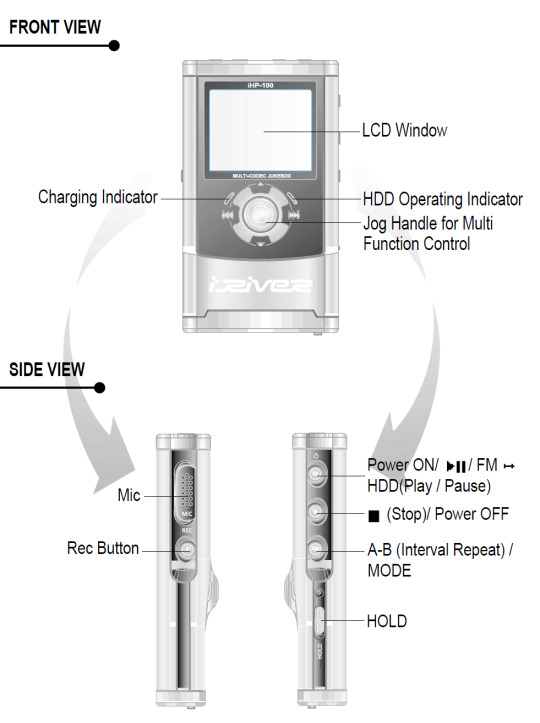
Yeah. This thing was also a portable recorder. At anytime you could just hold down the Rec button and start recording with the onboard mic, or using an external input (more on that later). On the right side, an A-B Interval control. You ever wanted to just listen to one part of a song on repeat to learn the lyrics? Just hold down the button. Lastly a hold switch to disable control inputs while it was in your pocket—no accidentally pausing the music.
Okay, back to the external input mentioned before. The top of the iHP-120 is wild.
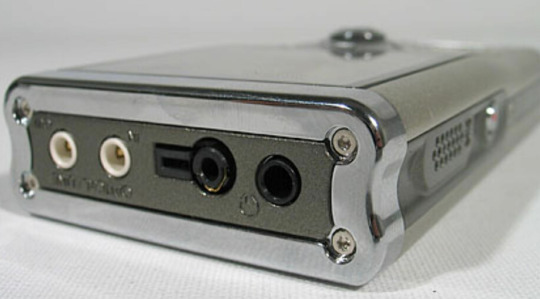
The top I/O panel of the iRiver iHP-120, with 4 jacks.
From right to left, you have a 3.5mm headphone jack (naturally), a 2.5mm microphone jack, the remote control port (more on this in a bit), and in white you have Line In/Out jacks which you could use to record as well as just plug in a second pair of headphones for a friend—jacks which support both 3.5mm analog input, as well as 3.5mm TOSLINK optical cables.

The TOSLINK 3.5mm male plug. A plug I only ever encountered on this device and the Sound Blaster X-Fi Titanium, a sound card I wrote a review of in 2009 which seems to still be up at PC Gamer and reading it now I don't know how any of my writing was ever published, let alone in print.
Chances are good you've never encountered this, it's phenomenally uncommon, and TOSLINK as a whole largely died with the emergence of HDMI—but this fucking mp3 player could both record and transmit fiber optic audio in uncompressed stereo or lossy 7.1 surround sound. In high school, I would plug the iHP-120 into our home theatre and listened to Porcupine Tree's Stupid Dream on repeat (side tangent, I'm pretty sad 5.1 album recording never really caught on, but the Dolby Atmos music format is better in every way, and I'm grateful Apple is bringing it into the mainstream).
"Okay, so we have an music player/text reader/voice recorder with optical audio, and basically every codec under the sun, what else could you go on about Erika?"
-you, the person reading this
THE REMOTE
Let me take you back to 2003. I was a depressed theatre kid teenager who would listen to Rooney on repeat on my Koss UR40s while crying over a girl who wanted nothing to do with me.
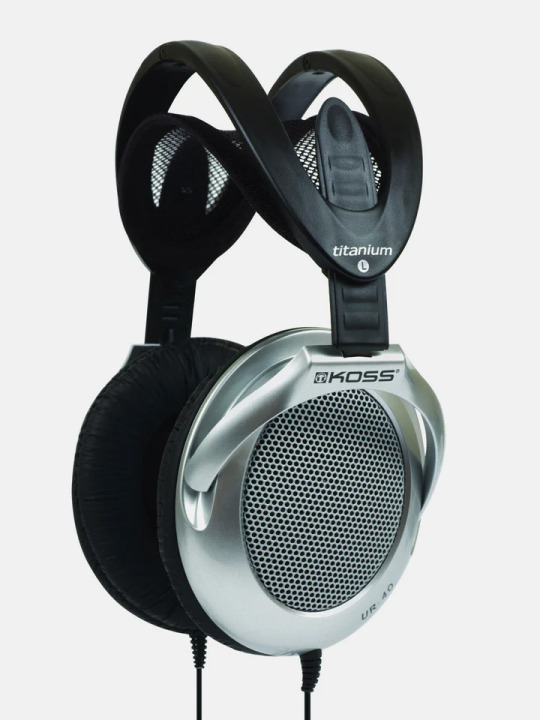
The Koss UR40 Headphones I wore like a fashion accessory everyday.
The other thing I wore everyday besides those headphones? Baggy cargo pants (it was acceptable at the time, I swear). Inside the right cargo pocket was my iRiver iHP-120, and clipped to the velcro flap of that cargo pocket was the iHP-115R remote control.
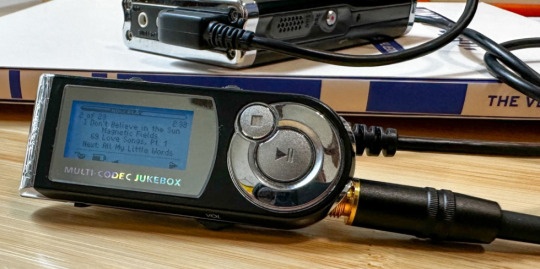
The iHP-120 remote unit
Every function of the iHP-120 could be controlled from this little fucker. Play/pause and stop buttons. Volume, skip track and recording are all here on rocker switches. You could even change the fucking bitrate of playback on this little thing, all without taking the actual mp3 player out of your pocket because the LCD screen on the remote has all the same info you'd get on the main unit.
The remote itself connected to the iRiver with that big plug you can see in the picture above (shamelessly stolen from Nathan Edwards who I worked with at PC Gamer in the late 2000s and only while writing this post discovered has already written a much more professional ode to the beauty of the iHP-120 this year).
You would plug your headphones into the remote, (or in my case you could also plug in your 1988 Chevrolet 2500 suburban's tape deck adaptor and have controls at your fingertips. No more distracted driving).

An image of a 1988 Chevorlet 2500 diesel Suburban. Not super relevant but god I miss my high school suburban. We would take the rear and middle benches out and put a queen-size mattress in the back, which 9 of my friends would ride on as we went to Little Caesar's for lunch. Also, cars just looked way fucking better back then.
I think I'm about done waxing nostalgic, but I really do miss the days of discrete devices—I kind of find myself fighting back against my smartphone. I have a camera I carry around, a pen and paper planner and writing notebook, and a kindle for reading. There's something appealing about not having my phone be my access to music either—rather, having a device that I just threw my music on and it plays it really well was rad. The iHP-120 was really fucking rad.
12 notes
·
View notes
Text
posting a couple of new doodles and an older piece of art for orctober! an orc version of my werewolf dell, local ska band keytarist ogg vorbis, and a vtuber model i've not used for anything yet :)



11 notes
·
View notes
Text
fre:ac is a free audio converter and CD ripper with support for various popular formats and encoders. It converts freely between MP3, M4A/AAC, FLAC, WMA, Opus, Ogg Vorbis, Speex, Monkey's Audio (APE), WavPack, WAV and other formats.
With fre:ac you easily rip your audio CDs to MP3 or M4A files for use with your hardware player or convert files that do not play with other audio software. You can even convert whole music libraries retaining the folder and filename structure.
The integrated CD ripper supports the CDDB/GNUdb online CD database. It will automatically query song information and write it to ID3v2 or other title information tags.
15 notes
·
View notes
Text
went to make a joke about how music format ogg vorbis sounds like a pervert name but did a search first to see why it's called that. but my afternoon ADHD dose is kicking in and i'm mid deep cleaning the greasy vents of my microwave and about to clean my sinks p-trap and don't have time to read into video game history
3 notes
·
View notes
Text
Fun fact: when you rip the radio songs from Animal Crossing New Horizons and store them in Ogg Vorbis, all but one will be less than 800 KB in size.
The only exception at 1.81 MB is Marine Song 2001 by virtue of its sheer duration.
You might know that the inventory icon for these songs is a yellow 🎵.
Between that and the N64 game originally going with MiniDiscs until they switched to the eight notes, I thought I'd use this as an excuse to practice making my own inventory icons.

Yeah, it wouldn't make sense to put one of these on a record player but I don't care.
4 notes
·
View notes
Text
Train vs. Sixpence None the Richer - Hey Soul Kisster
Download: OGG Vorbis - M4A (AAC) - MP3 (not recommended)
I don't actually remember precisely where the inspiration for this one hit me -- probably the shower. The finished product managed to get a listener to say he hated it while also admitting that I made the pairing work, which is a definite first.
Also, five new bootlegs in the past six months must be some kind of personal record... at least in the past 15 years.
As always, this and many other fine bootlegs can be found at my bootlegs page.
#mashups#sixpence none the richer#hey soul sister#kiss me#train band#bootlegs#music#scintilla's bootlegs
10 notes
·
View notes
